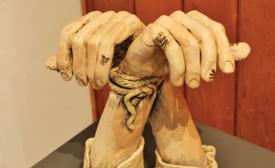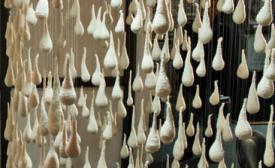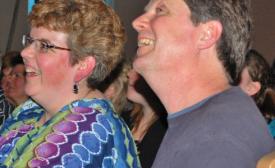Unveil your heart
Rohina Malik was 14 when her family moved from London, England, to Chicago. It was there that she lived through—and continues to live through—the misunderstandings about Muslims, veiled Muslim women in particular.
Rohina Malik was 14 when her family moved from London, England, to Chicago. It was there that she lived through—and continues to live through—the misunderstandings about Muslims, veiled Muslim women in particular.
Canadian Mennonite is at an exciting place in its history, Larry Cornies told board members of the Canadian Mennonite Publishing Service (CMPS) at their annual meeting and fundraiser on March 24 at Toronto United Mennonite Church. “We’ve come to the intersection of Christendom’s decline, the rise of new communication tools and a new paradigm in leadership,” he said.
The Hunger Games is on its way to becoming one of the biggest blockbuster films of all time. Two sequels are assured. Since it is aimed at a teenage/young adult demographic—in spite of its 14A rating—it is important to take note of what our young people are watching.
My four favourite films of 2011 all had Christian themes, something that has certainly never happened before. Two of them—Of Gods and Men and The Way—were reviewed in Canadian Mennonite last year.
Although sailing troubled waters over the past 50 years, Mennonite novelists have taught Mennonite readers how to approach their texts with boldness and humility as “we learn more about ourselves through their works of art,” Paul Tiessen said last month in wrapping up a nine-week series of lectures by Mennonite writers at Conrad Grebel University College.

‘6.5 Weeks’ by Cliff Derksen (clay with patina finish). The artist tried to sculpt his murdered daughter’s bound hands, but couldn’t bear to. Instead, he sculpted his own because he wishes they would have been his hands bound, instead of hers.

‘70 x 7’ by Odia Derksen (100 percent felted wool, detail). The hanging represents tears and giving up hatred.

‘Evidence of a trial’ by Odia Derksen (100 percent felted wool, detail). Derksen crocheted nearly every day of the trial. Every time she felt a new emotion, she would change colours. Cream represents feeling neutral or doing fine. Red represents pain and black represents anger.
It is indescribable, the feeling of losing a loved one, especially when that person is lost as the result of a murder.
Ancestral worship for Mennonite writers is a great temptation, Julia Spicher Kasdorf told a faculty forum at Conrad Grebel University College on Feb. 17 as part of the award-winning Mennonite poet’s three-day presence on campus as a visiting scholar sponsored by the Rod and Lorna Sawatsky Fund.
At the age of 17, dancer Peter Quanz of Wilmot Mennonite Church was already living in Winnipeg on his own. Before heading to Winnipeg, he commuted to an arts high school in nearby Kitchener, instead of attending his local high school. His parents had always supported his interest in dance, although they all kept it quiet in the congregation and community.
I recently received two books by authors in their 90s: Nearing Home by Billy Graham, and Time for Outrage by Stéphane Hessel, a retired French diplomat and concentration camp survivor who helped draft the United Nations Declaration of Human Rights. Each book conveys a strong sense of mission and each is made more compelling by the author’s age.
Peter Etril Snyder is known the world over for his sensitive paintings of Old Order Mennonites in the Waterloo Region. Although he had just retired from his gallery and painting for health reasons, he was intrigued when Tundra Books came to him with Nan Forler’s poems of an Old Order girl’s life over the course of a year, feeling that they epitomized the world he knew so well.
Peter Etril Snyder is known the world over for his sensitive paintings of Old Order Mennonites in the Waterloo Region.
In 1985, around 2,500 people walked the Camino de Santiago, a medieval pilgrimage route in northern Spain. Ten years later, the number jumped tenfold. The year that I did it, 2005, there were 95,000 of us. The popularity of this endeavour is one thing, but more surprising is the fact that most pilgrims profess no religious faith or motivation.
Mennonite Central Committee (MCC) recently conducted a re-visioning process called New Wine/New Wineskins: Reshaping MCC for the 21st Century, to review various aspects of the organization. The essays in this collection continue this conversation of exploration of MCC’s work and purpose, and the relationship with its supporting congregations.
Mennonite Church U.S.A. executive director Ervin Stutzman believes people today can learn from those who faced challenges over peace in the past, gaining perspective and humility as they study history. That’s why he wrote From Nonresistance to Justice: The Transformation of Mennonite Church Peace Rhetoric, 1908-2008, published this year by Herald Press.
Harry Potter and the Deathly Hallows: Part 2 (DH2), the final instalment of the hugely popular eight-part Harry Potter film series, was released this summer to overwhelming acclaim.
What does it mean for a faith-based organization to make faith and spirituality an integral part of its board meetings and planning?
As Mennonites living in the peace and prosperity of Canada, we sometimes wonder how to keep the stories of our past alive. We wonder whether our children and grandchildren will know about the hardships and suffering of an earlier generation.
“So you want to kill some Nazis?” Dr. Erskine asks the short, skinny asthmatic wanna-be war hero in this summer’s big superhero film. “I don’t want to kill anyone,” comes the reply. “I just don’t like bullies.” Somehow this convinces Erskine that the young man, whose name is Steve Rogers (Chris Evans), is a good, compassionate person.
Recently I stood in line-ups for two different kinds of “Mennonite” foods. In one line I waited, along with many others, for my order from the annual Laotian Mennonite spring roll sale. A week later I waited for my two dozen Russian Mennonite fleisch perishky (meat-filled buns).
Based on John Kiser’s 2003 book The Monks of Tibhirine: Faith, Love and Terror in Algeria, Xavier Beauvois’ 2010 movie, Of Gods and Men, was called “best perhaps the best movie on Christian commitment ever made,” by Richard Lowry in the New York Post.

After 20 years of service as children’s choir director at Sargent Avenue Mennonite Church, Winnipeg, Man., Lori Wiebe gets to sit back on May 8 and enjoy an encore of songs from past musicals she has directed over the years. Pictured at right is Mel Braun, who is also leaving his post as accompanist after 11 years.
For Lori Wiebe, the May 8 performance of The Rock Slinger and his Greatest Hit, a musical about David and Goliath, was a significant milestone in her life. After 20 years of directing the Sargent Avenue Mennonite Church Children’s Choir, this was her last musical.
Three days before the official May 2 release date for Mennonite Girls Can Cook, Herald Press officials were already ordering a reprint. The cookbooks had arrived early from the printer, and workers at the Herald Press warehouses in Waterloo, Ont., and Scottdale, Pa., were filling 600 pre-orders and responding to nearly 3,000 new orders.
“Will the fellows like my cooking?” wondered Nettie Redekopp in 1954 as she arrived at the Pax post-World War II rebuilding project in Wedel, Germany. That question haunted her for years, but finally in 2010 she dredged up the courage and began to call those whose phone numbers she could find.
Writers with Mennonite roots, like David Bergen, Miriam Toews and Di Brandt, have long dominated southern Manitoba’s literary scene. Now, the community’s music scene is experiencing a similar sort of influence.
About a year ago some Mennonite Economic Development Associates (MEDA) staff saw the play Iron Will in Hamilton, Ont. So inspired were they by its microfinance message that they came back to the Waterloo office wondering if it could be performed there.